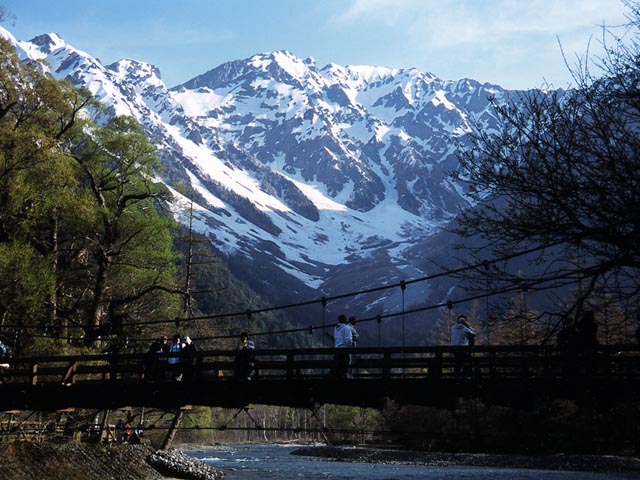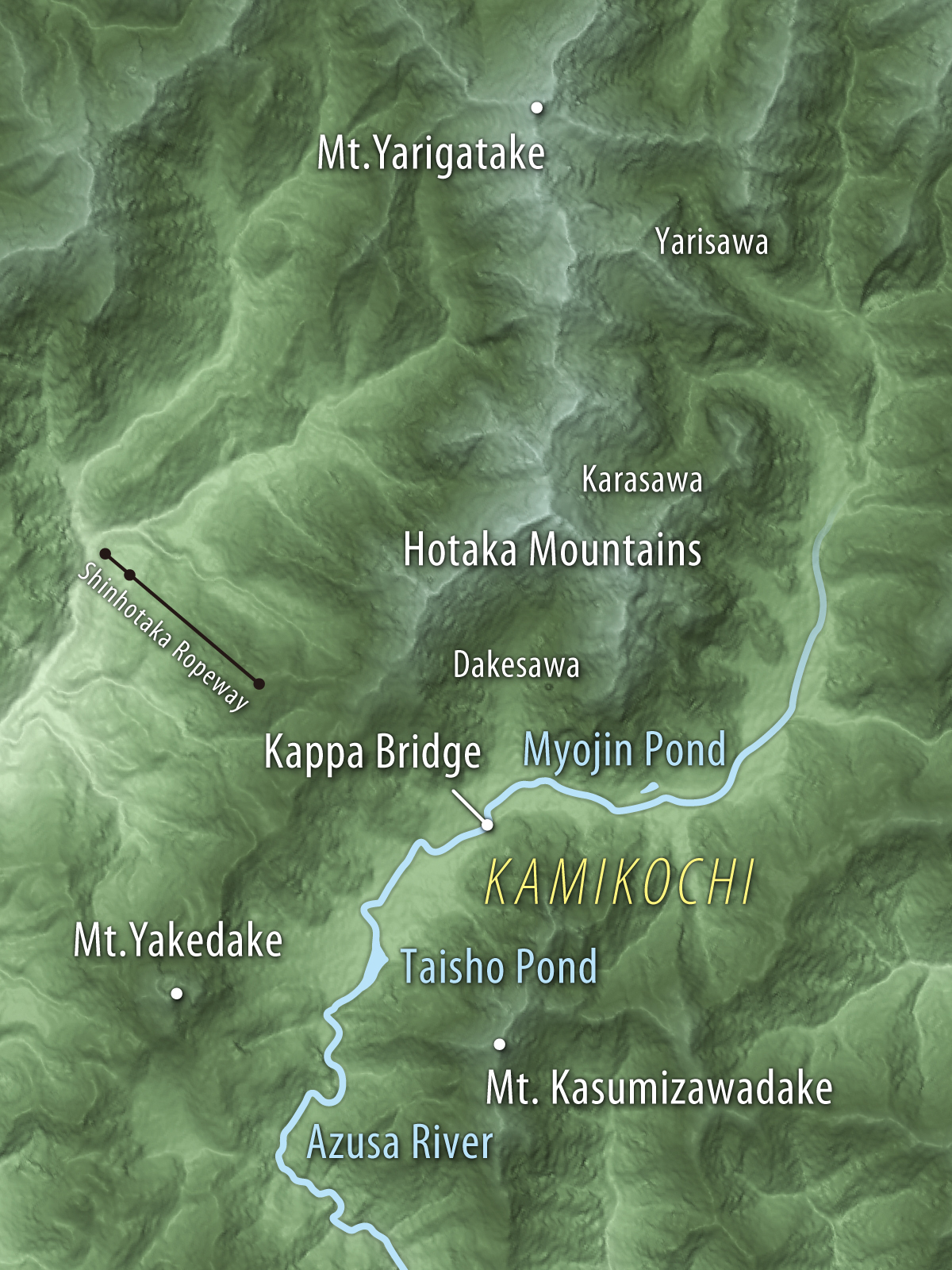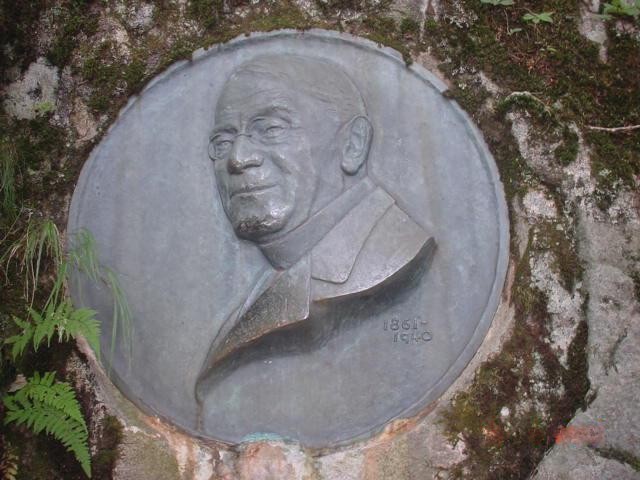KamikÅchi on:
[Wikipedia]
[Google]
[Amazon]
 is a remote mountainous highland valley within the
is a remote mountainous highland valley within the
. The Agency for Cultural Affairs. Accessed June 28, 2008. It is sometimes referred to as the "Japanese Yosemite Valley," although it is considerably smaller than its Californian counterpart.
 KamikÅchi is a high mountain valley approximately 18 kilometers in length. The average elevation of the valley floor ranges between roughly above sea level at the south end and roughly at the northern tip.
KamikÅchi is located in the
KamikÅchi is a high mountain valley approximately 18 kilometers in length. The average elevation of the valley floor ranges between roughly above sea level at the south end and roughly at the northern tip.
KamikÅchi is located in the
 KamikÅchi was logged extensively until the mid-19th Century. The Rev. Walter Weston, a British Anglican missionary, is credited through his writing with sparking interest in recreational
KamikÅchi was logged extensively until the mid-19th Century. The Rev. Walter Weston, a British Anglican missionary, is credited through his writing with sparking interest in recreational
 For rail passengers approaching from Matsumoto an integrated park transportation ticket is available using the Highland Rail service of the
For rail passengers approaching from Matsumoto an integrated park transportation ticket is available using the Highland Rail service of the
Winter kept us warm in Kamikochi's silence
, ''
File:150920 Mt Yake-dake Kamikochi Japan01n.jpg, Azusa River flows through KamikÅchi
File:150920 Gakusawa wetlands Kamikochi Japan01s3.jpg, Gakusawa wetlands
File:150920 Taisho-ike Kamikochi Japan10n.jpg, Lake Taisho
Official KamikÅchi website
* â
Kamikochi.org: Kamikochi website
KamikÅchi Visitors Center
A guide to hiking in Kamikochi
{{DEFAULTSORT:Kamikochi Valleys of Japan ChÅŦbu-Sangaku National Park Hida Mountains Landforms of Nagano Prefecture Natural monuments of Japan Special Places of Scenic Beauty Nature conservation in Japan Japan Alps Tourist attractions in Nagano Prefecture
Hida Mountains
The , or , is a Japanese mountain range which stretches through Nagano, Toyama and Gifu prefectures. A small portion of the mountains also reach into Niigata Prefecture. William Gowland coined the phrase "Japanese Alps" during his time in Japan, ...
range, in the western region of Nagano Prefecture
is a landlocked prefecture of Japan located in the ChÅŦbu region of HonshÅŦ. Nagano Prefecture has a population of 2,052,493 () and has a geographic area of . Nagano Prefecture borders Niigata Prefecture to the north, Gunma Prefecture to the ...
, Japan
Japan ( ja, æĨæŽ, or , and formally , ''Nihonkoku'') is an island country in East Asia. It is situated in the northwest Pacific Ocean, and is bordered on the west by the Sea of Japan, while extending from the Sea of Okhotsk in the north ...
.
It has been preserved in its natural state within ChÅŦbu-Sangaku National Park. It is designated as one of Japan's National Cultural Assets, on the list of Special Natural Monuments and Special Places of Scenic Beauty.KamikÅchi. The Agency for Cultural Affairs. Accessed June 28, 2008. It is sometimes referred to as the "Japanese Yosemite Valley," although it is considerably smaller than its Californian counterpart.
Geography
 KamikÅchi is a high mountain valley approximately 18 kilometers in length. The average elevation of the valley floor ranges between roughly above sea level at the south end and roughly at the northern tip.
KamikÅchi is located in the
KamikÅchi is a high mountain valley approximately 18 kilometers in length. The average elevation of the valley floor ranges between roughly above sea level at the south end and roughly at the northern tip.
KamikÅchi is located in the Hida Mountains
The , or , is a Japanese mountain range which stretches through Nagano, Toyama and Gifu prefectures. A small portion of the mountains also reach into Niigata Prefecture. William Gowland coined the phrase "Japanese Alps" during his time in Japan, ...
, the "Northern Alps" of the Japanese Alps
The is a series of mountain ranges in Japan which bisect the main island of Honshu. The peaks that tower over central Honshu have long been the object of veneration and pilgrimage. These mountains had long been exploited by local people for raw m ...
. The surrounding mountains reach . KamikÅchi is bordered on its northern end by Mount Hotaka, and on its southern end by Mount Yake
literally, ''"Burning mountain"'' is an active volcano in the Hida Mountains, lying between Matsumoto, Nagano Prefecture, and Takayama, Gifu Prefecture, Japan. It is one of the 100 Famous Japanese Mountains, reaching at the highest peak.
Geog ...
, an active volcano.
The Azusa River, the headwater of Japan's longest river, the Shinano River, flows the length of the valley, filling Lake TaishÅ at the base of Mt. Yake. Lake TaishÅ received its name because it was formed by the eruption of Mt. Yake in 1915, which was part of the TaishÅ period in Japan.
Because of the relatively flat topography of the Kamikochi Valley, marshes and ponds are a common feature, including the Takezawa Marsh, Tashiro Pond, and Myojin Pond. As the waters are mainly from melted snow runoff or underground aquifers, the water temperature is cold, even in the height of summer. The Tokusawa area at the far northern end of the valley served as a grazing area for horses and cattle until 1934, when the area was completely integrated into the park.
Hiking
Kamikochi is a very popular hiking destination, there are an abundance of mountain huts and camping sites that make overnight hiking easy to manage. The most famous hike in the area is Yarigatake which is easily accessible from Kamikochi and often combined with Oku-Hotaka as a multi-day hike.History
 KamikÅchi was logged extensively until the mid-19th Century. The Rev. Walter Weston, a British Anglican missionary, is credited through his writing with sparking interest in recreational
KamikÅchi was logged extensively until the mid-19th Century. The Rev. Walter Weston, a British Anglican missionary, is credited through his writing with sparking interest in recreational mountaineering
Mountaineering or alpinism, is a set of outdoor activities that involves ascending tall mountains. Mountaineering-related activities include traditional outdoor climbing, skiing, and traversing via ferratas. Indoor climbing, sport climbing, a ...
in Japan and also with lobbying to preserve the KamikÅchi area. Each year in June, the Weston Festival is celebrated at Kamikochi in recognition of his contribution to the conservation of the Northern Japan Alps.
Japanese novelist Ryunosuke Akutagawa also contributed to a boom in domestic tourism when he published his book Kappa
Kappa (uppercase Î, lowercase Κ or cursive ; el, ΚΎÏÏÎą, ''kÃĄppa'') is the 10th letter of the Greek alphabet, representing the voiceless velar plosive sound in Ancient and Modern Greek. In the system of Greek numerals, has a value o ...
in 1927. The naming of the Kappa-Bashi, the narrow pedestrian suspension bridge over the Azusa River mentioned in the novel predates the book's publication. The origin of the naming of the bridge is uncertain, but is more commonly thought to refer to Kappa
Kappa (uppercase Î, lowercase Κ or cursive ; el, ΚΎÏÏÎą, ''kÃĄppa'') is the 10th letter of the Greek alphabet, representing the voiceless velar plosive sound in Ancient and Modern Greek. In the system of Greek numerals, has a value o ...
, mythical water deities said to inhabit Japan's mountain streams and rivers.
' kanji'' įĨåĢå
(''Kami-ko-uchi'') were also used to write "KamikÅchi," but äļéŦå° (''Kami-kÅ-chi'') has become the common way to write the name.
Park facilities include two camping areas, a number of hotels (western-style and traditional Japanese ryokan), a post office, a tourist information center and some souvenir shops, mainly located between the bus and taxi terminal and Kappa-bashi bridge.
Access and transportation
As the entire Kamikochi valley is protected as part of the ChÅŦbu-Sangaku National Park, road access is only granted to shuttle buses, taxis, forestry and maintenance workers' vehicles. Private vehicles have been restricted from entering the park beyond the Kama Tunnel for both traffic management and environmental reasons since 1994. Private cars are required to park at either the Hirayu or Sawando parking area from where shuttle buses or taxis transport visitors directly to the centrally located park visitor center. For rail passengers approaching from Matsumoto an integrated park transportation ticket is available using the Highland Rail service of the
For rail passengers approaching from Matsumoto an integrated park transportation ticket is available using the Highland Rail service of the KamikÅchi Line
The is a railway line operated by the Japanese private railway operator Alpico KÅtsÅŦ in the western suburbs of Matsumoto, Nagano Prefecture. The line connects with , the transportation gateway to KamikÅchi and the Hida Mountains.
Stations ...
to Shin-Shimashima rail terminal and then the Highland Bus service provided by Alpico KÅtsÅŦ. The journey to the center of the park from Matsumoto Station by rail and shuttle bus takes approximately 1 hour 50 minutes.
Longer distance and overnight buses directly to the park are available from Tokyo (Shinjuku), Nagoya, Kyoto, and Osaka.
The park is officially open from mid-April to mid-November, with peak crowds during the summer school holidays (end of July through the end of August) and when the autumn leaves are at their peak in October.Hohmann, Skye,Winter kept us warm in Kamikochi's silence
, ''
Japan Times
''The Japan Times'' is Japan's largest and oldest English-language daily newspaper. It is published by , a subsidiary of News2u Holdings, Inc.. It is headquartered in the in Kioicho, Chiyoda, Tokyo.
History
''The Japan Times'' was launched by ...
'', 4 March 2012, p. 10.
Surrounding mountains
* Mount Hotaka * Mount Yari *Mount Yake
literally, ''"Burning mountain"'' is an active volcano in the Hida Mountains, lying between Matsumoto, Nagano Prefecture, and Takayama, Gifu Prefecture, Japan. It is one of the 100 Famous Japanese Mountains, reaching at the highest peak.
Geog ...
*Mount ChÅ
at is a mountain located in Japan. Mount ChÅ is part of the Hida Mountains (Northern Alps) in ChÅŦbu-Sangaku National Park, and is located in the cities of Azumino and Matsumoto in Nagano Prefecture. It is located to the south of Mount JÅne ...
*Mount JÅnen
is one of the 100 Famous Japanese Mountains, reaching the height of . It is situated in Japan's Hida Mountains in Nagano Prefecture and in ChÅŦbu-Sangaku National Park. The shape of the mountain looks like the triangle. It can be seen from ...
* Mount Kasumizawa
See also
* List of Special Places of Scenic Beauty, Special Historic Sites and Special Natural Monuments * Tourism in Japan * ChÅŦbu-Sangaku National ParkReferences
External links
* âOfficial KamikÅchi website
* â
Kamikochi.org: Kamikochi website
KamikÅchi Visitors Center
{{DEFAULTSORT:Kamikochi Valleys of Japan ChÅŦbu-Sangaku National Park Hida Mountains Landforms of Nagano Prefecture Natural monuments of Japan Special Places of Scenic Beauty Nature conservation in Japan Japan Alps Tourist attractions in Nagano Prefecture